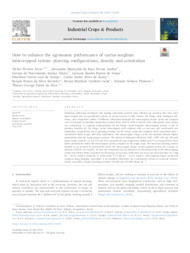How to enhance the agronomic performance of cactus-sorghum intercropped system: planting configurations, density and orientation.
How to enhance the agronomic performance of cactus-sorghum intercropped system: planting configurations, density and orientation.
Author(s): ALVES, C. P.; JARDIM, A. M. da Ro F.; ARAÚJO JÚNIOR, C. do N.; SOUZA, L. S. B. de; ARAUJO, G. G. L. de; SOUZA, C. A. A. de; SALVADOR, K. R. da S.; LEITE, R. M. C.; PINHEIRO, A. G.; SILVA, T. G. F. da
Summary: Clarifying cultivation techniques and making production systems more efficient are practices that have been much sought after in agricultural systems in recent decades. In this context, the forage yield, biological efficiency, and competitive ability, of different cultivation strategies for intercropping forage cactus and sorghum were determined in biosaline production systems from 2018 to 2020 in Brazil. Four experiments were carried out, comprising: 1) cropping configurations for the forage cactus-sorghum intercropping system; 2 and 3) planting densities for the forage cactus intercropped with sorghum with an east-west and north-south row orientation, respectively; and 4) planting densities for the forage cactus and sorghum. Each experiment used a randomised block design with four replications. The intercropped forage cactus and sorghum showed higher productivity than the monocropped systems. The indices of biological efficiency (LER, ATER, LEC and SPI with mean values equal to 1.6, 1.8, 0.6 and 29.0, respectively) and competitive ability (ALGY in average 870.6) show better performance under the intercropped system compared to the single crops. The increased planting density resulted in an increase in productivity under the intercropped forage cactus-sorghum system (on average an increase of 69.4% dry matter). In turn, the orientation had no influence on the productivity of the intercropping system but offered better conditions for the forage cactus when cultivation was in an east-west direction (21.7 Mg ha 1 of dry matter) compared to north-south (17.5 Mg ha 1 of dry matter). Intercropping forage cactus and sorghum using biosaline agriculture is an excellent alternative for a production system in semi-arid environments, especially at higher planting densities (50,000 and 100,000 plants ha 1).
Publication year: 2022
Types of publication: Journal article
Unit: Embrapa Semi-arid Region
Observation
Some of Embrapa's publications are published as ePub files. To read them, use or download one of the following free software options to your computer or mobile device. Android: Google Play Books; IOS: iBooks; Windows and Linux: Calibre.
Access other publications
Access the Agricultural Research Database (BDPA) to consult Embrapa's full library collection and records.
Visit Embrapa Bookstore to purchase books and other publications sold by Embrapa.

